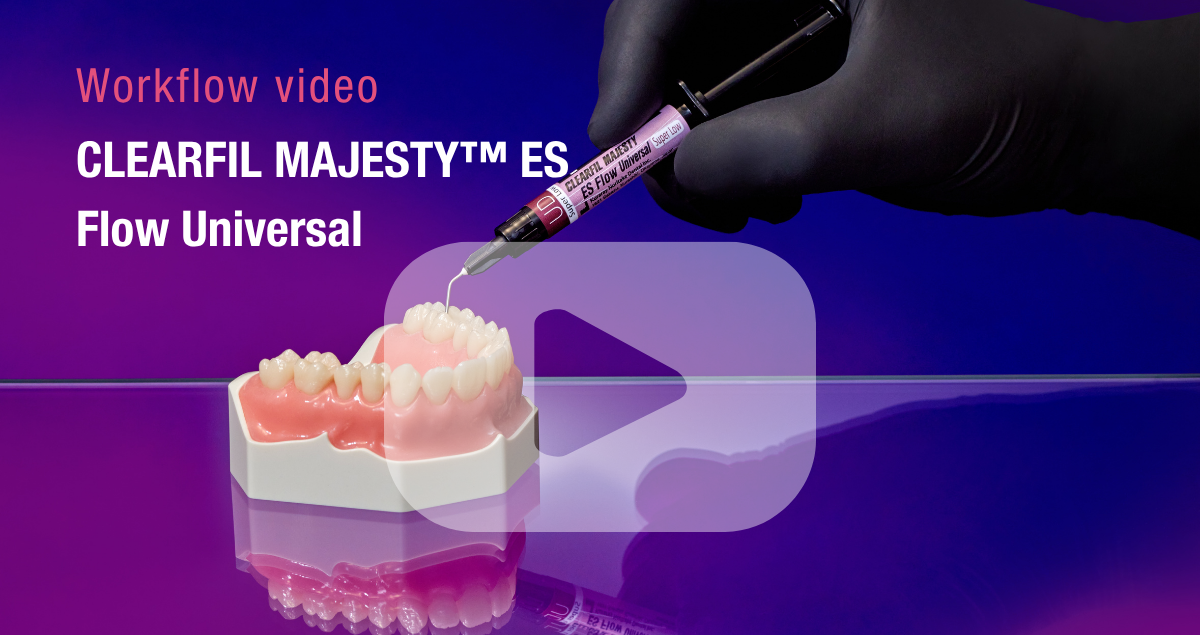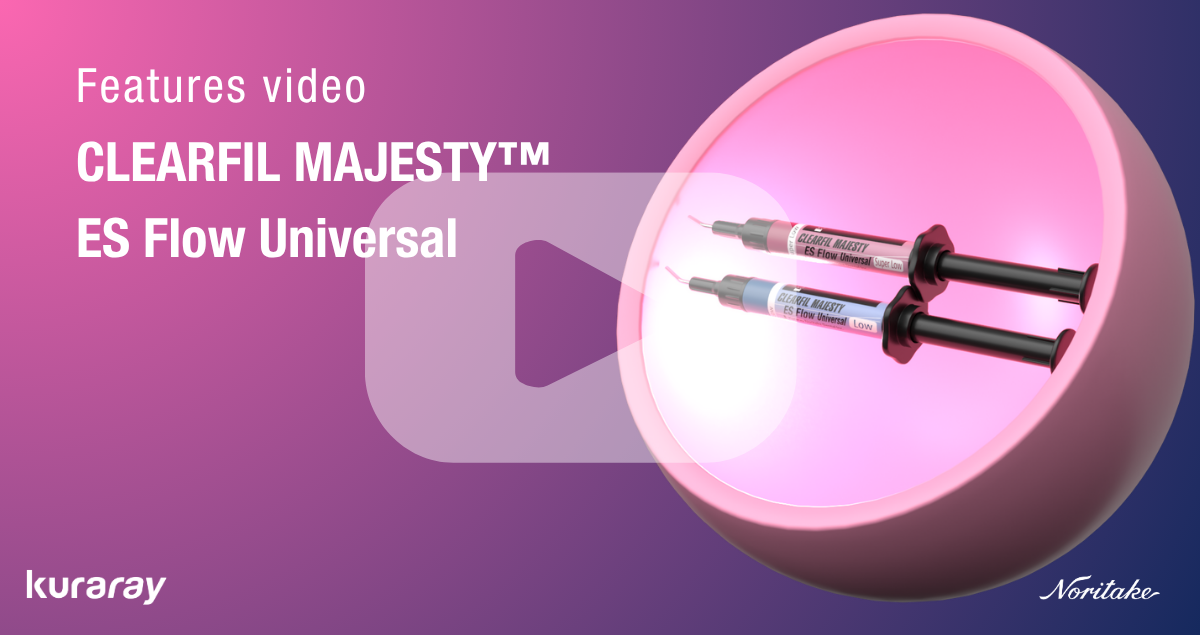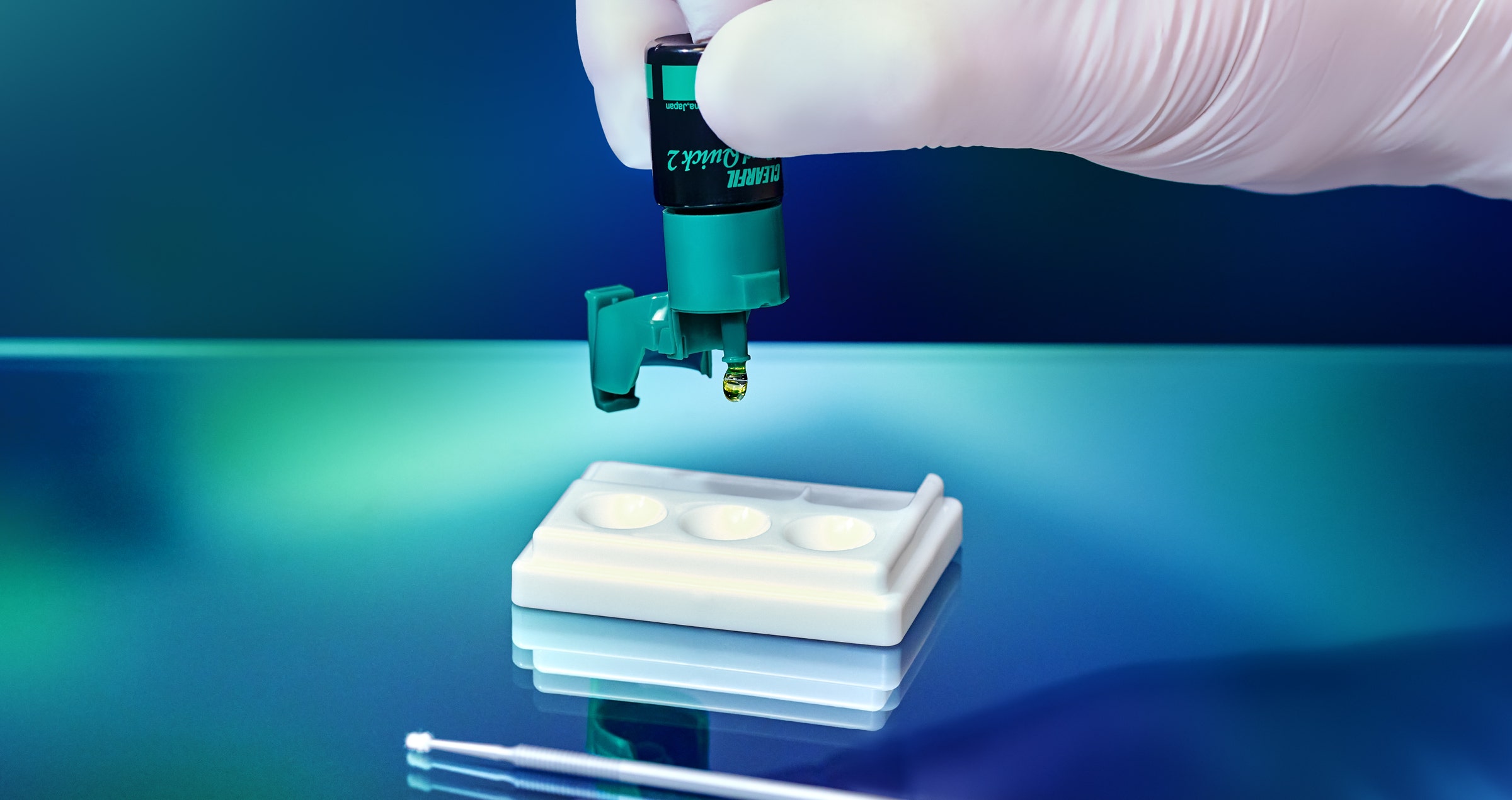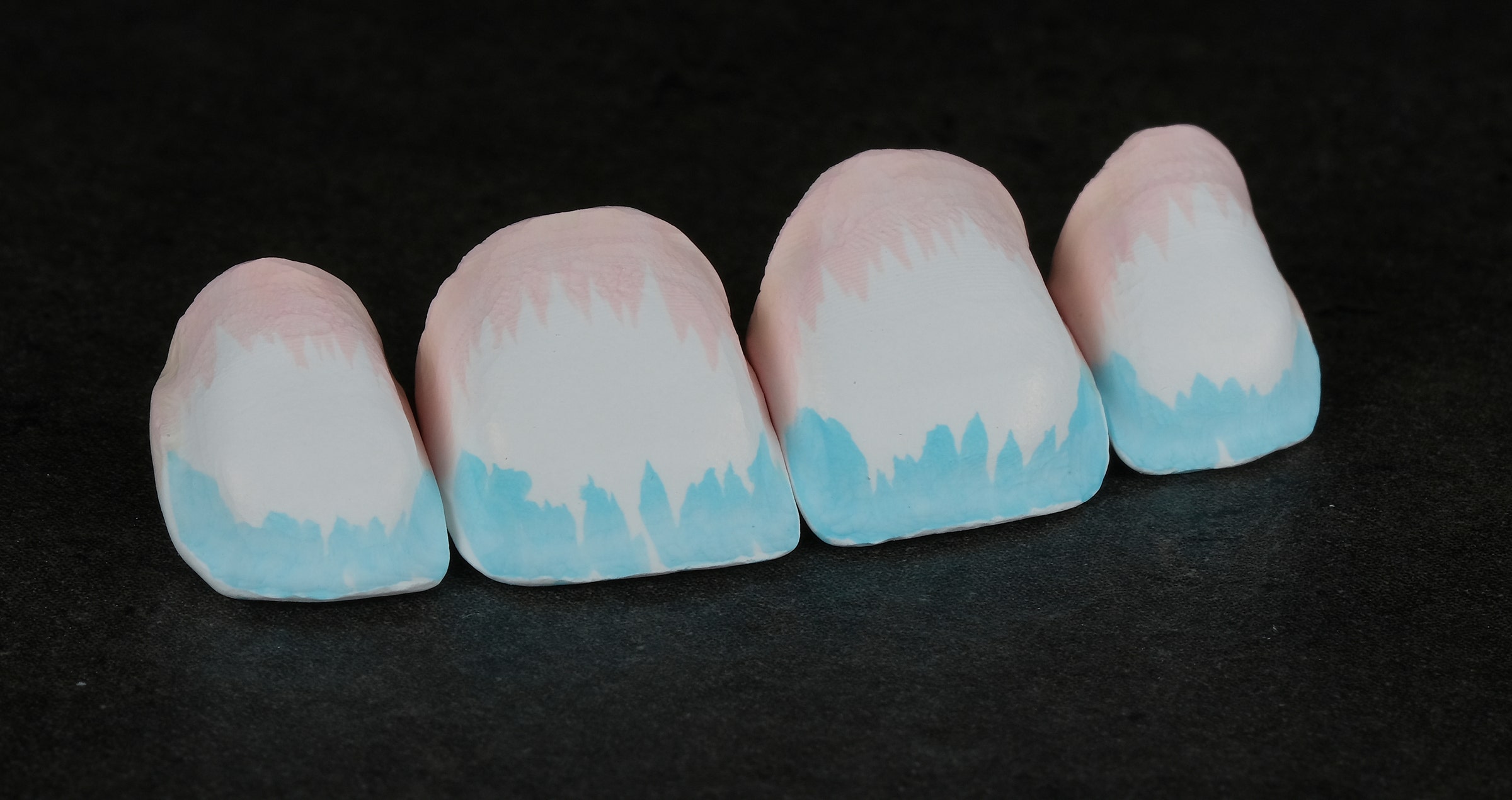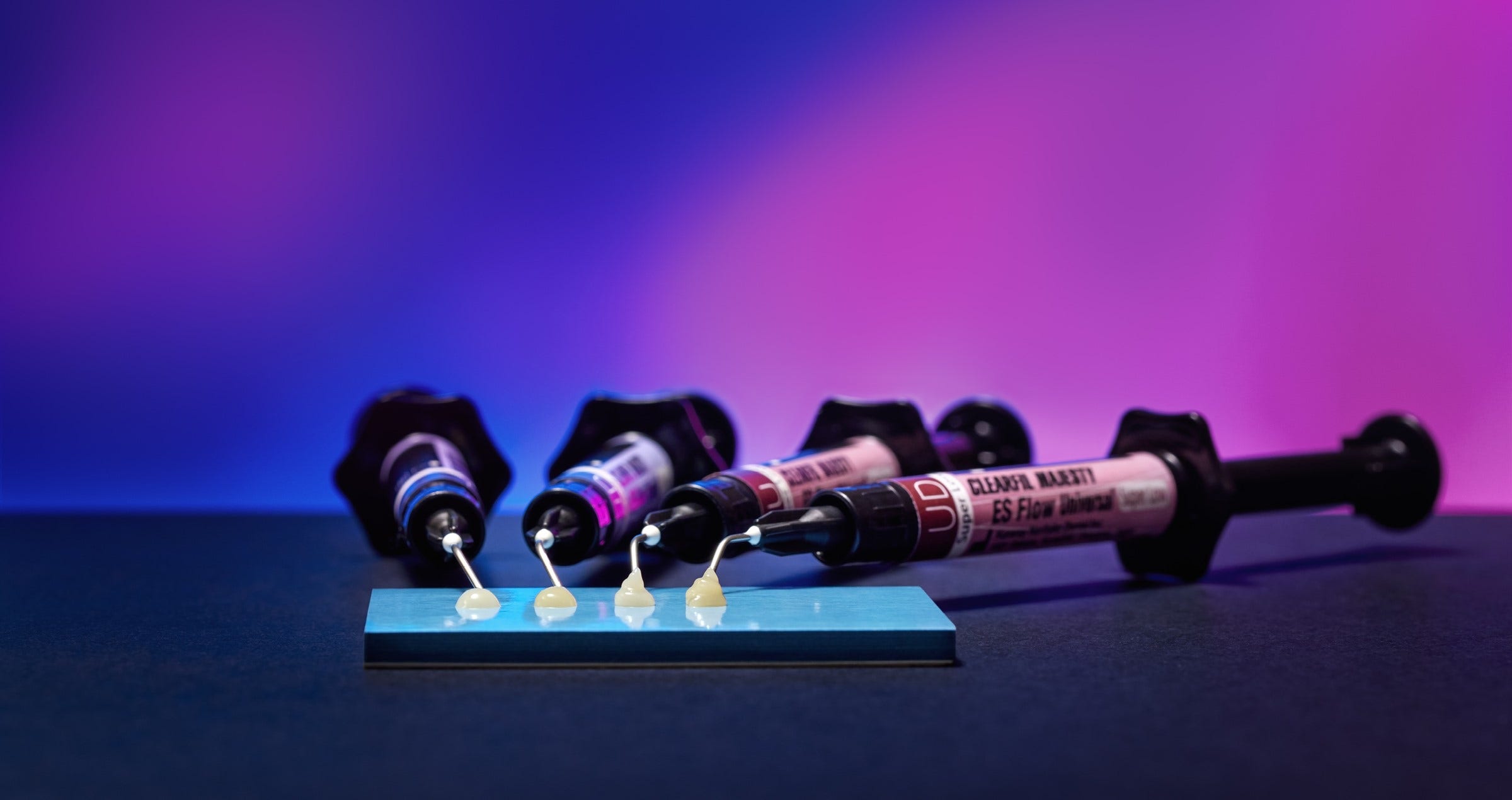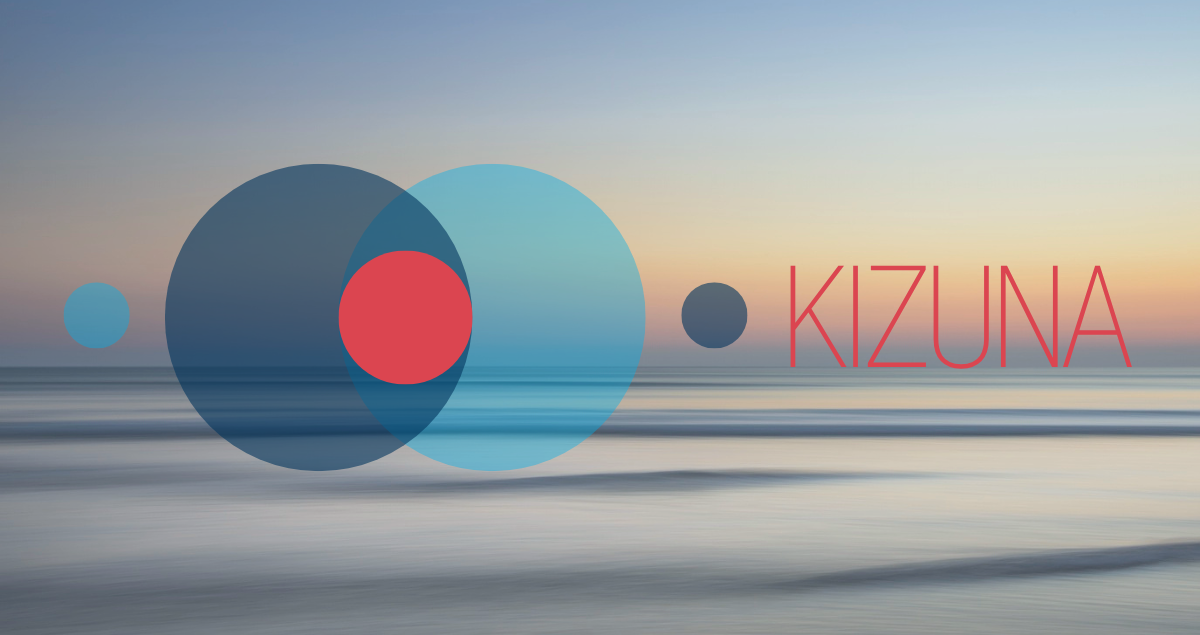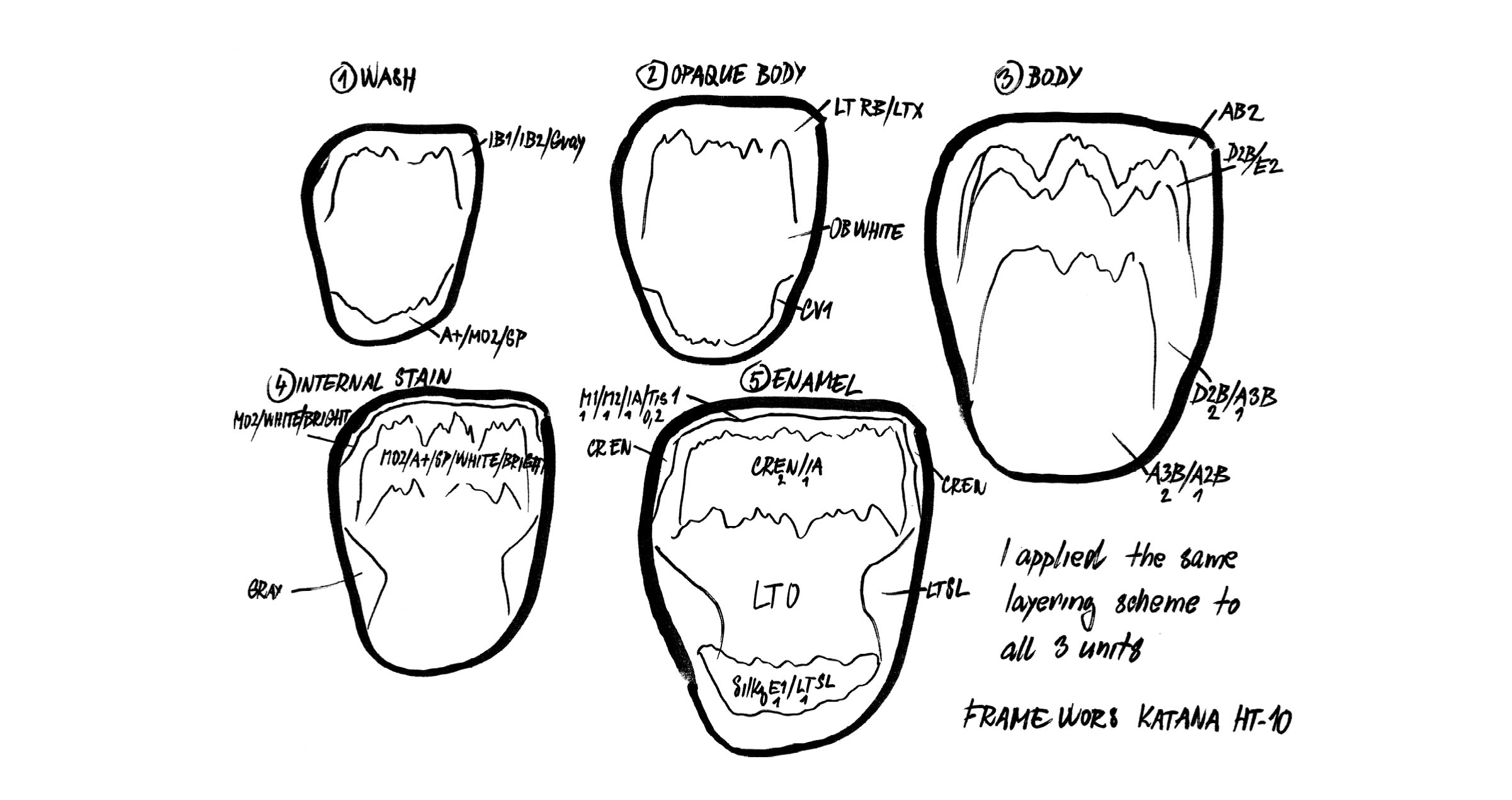Blog
Intuitive shade matching goes flowable!
A new universal adhesive born in Japan
Interview with the team at Kuraray Noritake Dental Inc., who developed and brought to life this new universal adhesive.
Streamlining, enhancing and refining adhesive procedures – these are the aims of an 5-person team at Kuraray Noritake Dental Inc. in Japan. Recently, the team has developed a next-generation universal adhesive CLEARFIL™ Universal Bond Quick 2 that offers quick and easy application combined with an optimised bonding performance. To learn more about the goals and achievements of the development project, and the benefits of the product, we had a conversation with them.
From left to right: Ryo Matsuura and Ryota Murayama (R&D Department), Kazutoshi Ikeda (Production Department), Marina Okada and Yamato Nojiri (Planning & Development Department).
Why did you decide to improve CLEARFIL™ Universal Bond Quick?
Universal adhesives like CLEARFIL™ Universal Bond Quick are very well received by dental practitioners all over the world mainly due to their versatility and procedural simplicity. In the clinical setting, however, we have identified room for improvement. For example, it can be difficult to establish thin, uniform and strong bonding layers with the currently available products. Water and solvents in universal adhesives often limit the formation of a strong bond layer. A thin bonding layer and the relatively thick oxygen inhibition layer make this type of bonding agent susceptible to degradation by water sorption from dentinal moisture. Highly viscous bonding agents also complicate the ease of application in small cavities and can easily lead to pooling of the adhesive in critical parts of the cavity. Adhesives with a relatively high viscosity may pool or accumulate along margins, and may form a layer that is too thick and may change the morphology of the abutment tooth, a critical factor potentially affecting the fit of an indirect restoration. Generally, bonding agents with a low film thickness and/or are low-filled or unfilled, in turn have a potentially negative effect on the strength of the bonding layer. At Kuraray Noritake Dental Inc., we wanted to address the aforementioned issues and have developed a universal adhesive that is easy to apply and facilitates the establishing of thin, uniform bonding layers exhibiting high strength.
What are the indications of CLEARFIL™ Universal Bond Quick 2?
The new universal adhesive is indicated for bonding procedures in the context of creating direct restorations with light-cured composite, sealing of a prepared cavity or abutment tooth as a pretreatment for indirect restorations, treatment of exposed root surfaces and hypersensitive teeth, and also the intraoral repair of fractured restorations. Furthermore, the product is a suitable adhesive in post-cementation and core build-up procedures as well as in adhesive cementing of indirect restorations. When used in the context of the cementing of indirect restorations, the bonding to tooth structure of PANAVIA™ SA Cement Universal and of other manufacturers’ self-adhesive resin cements improves, leading to higher bond strengths.
What are the corresponding general benefits of CLEARFIL™ Universal Bond Quick AND CLEARFIL™ Universal Bond Quick 2?
The general benefits of both products are that they may be used with any etching procedure, plus the fact that there is no need to wait for the adhesive to penetrate the tooth structure after application. In addition, both products contain the original MDP monomer and the amide monomer, responsible for the formation of a thin and strong surface coating. Both products exhibit low technique sensitivity and are suitable for a wide range of indications. Finally, the adhesive monomers and fluoride offer extra protection to the underlying dentin.
Monomer image from the brochure
You mentioned the original MDP monomer as one of the essential components of the new adhesive and its predecessor. Is there a difference between this original MDP monomer and other MDP monomers available on the market?
Our MDP monomer is the only MDP monomer that is manufactured using the originally developed synthesis and purification process. Research has shown that the way MDP is manufactured has indeed an impact on the performance of the monomer itself1. While impurities and dimers detected in MDP monomers synthesized elsewhere negatively affected the immediate and aged micro-tensile bond strength in the in-vitro study, our MDP monomer shows high purity and more favourable test results.
Most universal adhesives need to be rubbed into the tooth structure extensively for 10 to 20 seconds. What did you do to eliminate the waiting time independent of the etching procedure, which led to an ultra-quick application procedure?
It is the amide monomer which is mainly responsible for an improved penetration speed into the tooth structure. The hydrophilicity of this monomer is much higher than the hydrophilicity of the HEMA monomer that is typically used. This provides for a better penetration into the moist dentin. The amide monomer’s polymerisation characteristics are better, and, following polymerisation, leads to higher stability in a wet environment due to the formation of a highly cross-linked polymer network. In combination with MDP, an efficient long-term performance will likely be achieved. For optimal outcomes, the adhesive is simply rubbed into the tooth structure as described in the IFU: “Apply BOND with a rubbing motion to the entire cavity wall with the applicator brush. No waiting time is required.”
What are the additional benefits that CLEARFIL™ Universal Bond Quick 2 has to offer?
First of all, we improved the viscosity and film thickness by optimizing the manufacturing method. The thin adhesive layer prevents pooling in the cavity, around abutments and along margins, creating a uniform bonding layer. Simply put, the new adhesive is applied thinly and spreads evenly. At the same time, the product offers high mechanical strength and excellent resistance to water sorption. Its bond strength is high in all etching modes and the new formulation allows for the product to be stored at room temperature.
Please explain the clinical benefit of an improved mechanical strength.
The risk of decreasing the film thickness lies in a possible decrease in the strength of the bonding layer which can lead to reduced bond durability. By introducing a new multifunctional urethane methacrylate monomer, we have been able to increase the strength. The effective advantage of the new bonding agent is that it can easily be used in small, difficult-to-access cavities or in cavities with complex morphology. The result is a thin yet strong adhesive layer that also allows for easy placement of any type of restoration.
How did you manage to improve the storage conditions?
Component stability was not an issue with CLEARFIL™ Universal Bond Quick. However, for a stable viscosity, it needed low-temperature storage. By optimizing the manufacturing method and decreasing the viscosity of CLEARFIL™ Universal Bond Quick 2, storage at room temperature became possible.
Was it difficult to integrate the new components and keep the existing benefits? How did you manage?
Integrating new components and removing others always means that the whole formulation needs to be rebalanced properly. This was particularly challenging for the multifunctional urethane methacrylate monomer we wanted to add. It improves the strength and hardness of the universal adhesive, but may affect adhesion depending on the amount of the compound in the formulation. Consequently, we needed to carefully find optimal balance, which took some time and required thorough testing, but in the end, we succeeded.
At the moment, the immediate dentin sealing technique is popular in indirect restoration procedures. What makes CLEARFIL™ Universal Bond Quick 2 suited for this technique?
Immediate dentin sealing is indeed a popular and useful technique that can result in significantly increased retention, reduced marginal leakage, improved bond strength, and less postoperative sensitivity. Using CLEARFIL™ Universal Bond Quick 2 in this context is beneficial as the procedure is quick, the resulting bonding layer is thin and strong, and the dentin is effectively protected.
Why should a dental practitioner switch to CLEARFIL™ Universal Bond Quick 2?
For users of CLEARFIL™ Universal Bond Quick, switching to CLEARFIL™ Universal Bond Quick 2 is worthwhile, as it offers additional advantages and improved performance while retaining the benefits of its predecessor. For users of other universal adhesives, the major benefit lies in the shortened application time: CLEARFIL™ Universal Bond Quick 2 is the only universal adhesive that can achieve a high bond strength and a high-strength bonding layer without any waiting time. In addition, it is suitable for a wide range of indications including core build-up procedures and cementation.
Thank you very much for these insights!
References
1. Yoshihara K, Nagaoka N, Okihara T, Kuroboshi M, Hayakawa S, Maruo Y, Nishigawa G, De Munck J, Yoshida Y, Van Meerbeek B. Functional monomer impurity affects adhesive performance. Dent Mater. 2015 Dec;31(12):1493-501.
Vervanging van amalgaam door flowable composiet met de nieuwe CLEARFIL MAJESTY™ ES Flow Universal
Case by Dr. Julien Molia
Ja, HET WERKT!
In de gedachten van veel tandartsen is het stevig verankerd dat flowable composieten geschikte liner- of basismaterialen zijn onder sterkere packable composieten en indirecte restauraties of als tijdelijk materiaal. Velen van hen nemen echter aan dat het gebruik beperkt is vanwege hun slechte mechanische eigenschappen.
NIEUWE GENERATIE FLOWABLES
Maar gelukkig behoort dat nu tot het verleden: Meerdere van de nieuwste generatie flowable composieten – zoals CLEARFIL MAJESTY™ ES Flow en CLEARFIL MAJESTY™ ES Flow Universal (beide van Kuraray Noritake Dental Inc.) – beschikken over mechanische eigenschappen die niet onderdoen voor de eigenschappen van packables. Als gevolg daarvan is het indicatiespectrum uitgebreid. Zo blijkt uit gegevens van de fabrikant dat CLEARFIL MAJESTY™ ES Flow Universal een hoog vulstofgehalte van 75 tot 78 wt/%, een buigsterkte van meer dan 150 MPa en een compressiekracht boven 370 MPa biedt. Dankzij deze hoge sterkte is het materiaal geschikt als betrouwbare en permanente oplossing die zelfs geschikt is voor belaste gebieden, zoals de occlusale oppervlakken van posterieure tanden.
Deze flowable composiet heeft echter nog meer te bieden: Het is leverbaar in twee niveaus van vloeibaarheid – LOW en SUPER LOW – en kan worden ingezet voor een breder scala aan persoonlijke voorkeuren en individuele indicatiespecifieke behoeften. En dat in slechts twee kleuren (Universal en Universal Dark). Dit laatste biedt het voordeel van intuïtieve kleurselectie, zelfs in het anterieure gebied, en is mogelijk dankzij een mix van technologieën voor kleuraanpassing, waaronder een technologie voor geoptimaliseerde lichtdiffusie en een glazuurachtige translucentie.
De volgende casus laat zien hoe CLEARFIL MAJESTY™ ES Flow Universal mijn leven eenvoudiger maakt bij posterieure restauratieprocedures.
CASUS
Bij deze patiënt moesten twee amalgaam restauraties in de mandibulaire rechter molaren (tanden # 46 en 47 volgens de internationale tandnummering) worden vervangen (afb. 1). Omdat het vulling mogelijk maakt en garant staat voor een voortreffelijke aanpassing op de caviteitswanden werd besloten CLEARFIL MAJESTY™ ES Flow Universal LOW te gebruiken als enig restauratiemateriaal. De positie van de te restaureren tanden maakte de kleurselectie eenvoudig: De kleur U (Universal) is geschikt voor alle posterieure restauraties.
De amalgaam restauraties werden verwijderd en cariës geëxcaveerd waarbij zoveel mogelijk van de gezonde tandstructuur werd behouden (afb. 2 en 3). Er werd een selectieve techniek voor het etsen van glazuur gekozen, gevolgd door het aanbrengen van een universeel adhesief (CLEARFIL™ Universal Bond Quick 2, Kuraray Noritake Dental Inc.). Vervolgens werden CLEARFIL MAJESTY™ ES Flow Universal in de LOW versie en de geselecteerde kleur U aangebracht in de caviteiten (afb. 4). Het innovatieve design van de spuit zorgt dat de aangebrachte flowable composiet zo goed als gatenvrij is. In lijn met de gebruiksaanwijzingen bij het product was de dikte van iedere laag max. 2 mm om volledige uitharding te garanderen (afb. 5 en 6), een beslissende factor voor de langetermijnprestaties van de definitieve restauraties. Iedere laag moet gedurende 10 tot 20 seconden (afhankelijk van de uithardingslamp) grondig uitharden voordat de volgende laag wordt aangebracht. Zoals getoond in afbeelding 7 maakt de lage vloeibaarheid van het geselecteerde materiaal enige mate van modelleren van de morfologie van het occlusale oppervlak mogelijk. In situaties waarbij meer anatomische details moeten worden hersteld, kan de stevigere SUPER LOW variant een optie zijn. Het tot hoogglans polijsten van de restauraties nam niet meer dan een paar seconden in beslag (afb. 8).
Afb. 1: Twee te vervangen amalgaam restauraties.
Afb. 2: Situatie na verwijderen van de bestaande amalgaam restauraties.
Afb. 3: Voor amalgaam kenmerkende verkleuring is zichtbaar onderaan in de grotere caviteit.
Afb. 4: Vulprocedure: Aanbrengen van de eerste laag f lowable composiet.
Afb. 5: Tweede molar al gevuld, eerste molar heeft nog een laag flowable composiet nodig.
Afb. 6: Vulprocedure voltooid.
Afb. 7: Mooie morfologie van het oppervlak en vermenging van kleuren.
Afb. 8: Resultaat na verwijdering van de cofferdam. De restauraties voegen zich qua kleur en oppervlakglans mooi naar de omringende gebitsstructuur.
EENVOUDIG ALTERNATIEF VOOR PACKABLE COMPOSIETEN
Met name in de lastig te bereiken gebieden in de mond kan het gebruik van een flowable composiet met uitgebalanceerde mechanische eigenschappen een goed alternatief zijn voor packables. Dankzij geavanceerde kleuraanpassing, vrijwel gatenvrij aanbrengen, eenvoudig aanpassen en modelleren en snel polijsten wordt het leven van de tandarts echt een stuk eenvoudiger.
Dentist:
JULIEN MOLIA
Dr. Julien Molia studeerde in 2008 af met een scriptie over computergestuurde implantologie. Hij heeft een algemene tandartspraktijk opgezet in Saint-Jean-de-Luz en richt zich op implantaatbehandelingen en kaakreconstructies. In 2017 behaalde hij een tweede universitaire graad in de implantologie om zijn expertise bij te werken en te verdiepen. Daarnaast heeft hij geavanceerde trainingen gevolgd op het gebied van digitale tandheelkunde, orthodontische minischroeven en mucogingivale chirurgie. Op basis van zijn toewijding aan weefselbehoud volgde hij privétrainingen bij Dr. Gil Tirlet en Dr. JeanPierre Attal in Parijs. Dr. Molia is een van de oprichters van het Franse Southwest BioTeam, een groep waarbinnen professionals toegewijd aan klinisch onderzoek en innovatie samenwerken.
Case by Kostia Vyshamirski, DT
KATANA™ Zirconia YML AND CERABIEN™ MiLai
Virtually every patient in need of restorative treatment desires functional restorations with an aesthetic appearance. However, the individual expectations and needs may be very different depending on the clinical situation (state of the natural tooth structure, parafunctional behaviour, periodontal health etc.), the patient’s financial resources and personal preferences. A versatile material combination fulfilling many different needs and desires is KATANA™ Zirconia YML finished using micro-layering with the new CERABIEN™ MiLai (both Kuraray Noritake Dental Inc.).
This system supports low invasive preparations due to a favourable minimum wall thickness of the merely monolithic multi-layered zirconium oxide prosthesis and a minimal thickness of the porcelain layer in the aesthetic zone. Moreover, the high strength zirconium oxide prosthesis combined with only a very thin layer of porcelains makes this technique extremely useful in patients with parafunctional habits like bruxism. Last but not least, consisting of a carefully compiled selection of internal stains and porcelain shades, CERABIEN™ MiLai supports the creation of individual 3D shade effects that mimic those of natural teeth even when space is limited. The following case example reveals how this is possible.
INITIAL SITUATION
The patient presented with concerns related to both function and appearance. During the diagnostic phase, it was determined that increasing the vertical dimension of occlusion (VDO) and creating a wax-up in the new jaw position would be necessary to improve both the occlusion and the aesthetic appearance of the smile.
Fig. 1. Intraoral scan of the maxillary teeth revealing severe tooth wear.
Fig. 2. Intraoral scan of both jaws confirming the need for an increase of the VDO.
Fig. 3. Intraoral scan: Occlusal view of the maxillary teeth.
TREATMENT PLANNING AND COMPUTER-AIDED DESIGN
Following the approval of the wax-up, the treatment plan was created. It consisted of restoring the four anterior incisors with zirconia crowns and performing direct composite restorations on the posterior and lower teeth. To conserve as much of the healthy tooth structure as possible, the space created was aligned to the required wall thickness of the planned restoration (framework + micro-layer of porcelain in the vestibular areas only). Following an aesthetic analysis, the crowns were designed with a minimal vestibular cutback. This was due to the patient’s functional problems, which would increase the chipping risk in case of using a more heavy cutback design with a thicker, more conventional porcelain layer. KATANA™ Zirconia YML offers exceptional aesthetics, requiring only a 0.3 mm reduction for the porcelain to achieve natural results. Therefore, it was the logical material choice for this specific case.
Fig. 4. Minimally invasive preparations for the crowns.
Fig. 5. Occlusal view of the preparations.
Fig. 6. Aesthetic analysis – a crucial step for achieving the desired new smile.
Fig. 7. Frontal view of the crowns in their final cutback design.
Fig. 8. Lateral view of the crowns in the CAD software.
CROWN PRODUCTION
Immediately after milling, the zirconia surface was treated with effect liquids. This kind of pre-sintered characterization helps enhance the characteristics of zirconia restorations. In the presented case, orange stain was applied to the cervical area, while a blue stain was used at the incisal edge. In addition, a white opaque liquid was applied to the inner surface of the central zirconia crowns to block out any discolouration from the underlying tooth structure. Following final sintering, the vestibular layer of porcelain was built up with CERABIEN™ MiLai using a combination of internal stains and porcelain micro-layering. After morphological adjustments and surface polishing, the restorations were completed by applying CERABIEN™ ZR FC Paste Stain and Glaze. Final polishing was then performed to enhance the natural appearance of the surfaces.
Fig. 9. Effect liquids applied to the cervical and incisal areas of the crowns.
Fig. 10. Treatment of the central incisor crowns’ inner surfaces.
Fig. 11. KATANA™ Zirconia YML framework after sintering.
Fig. 12. CERABIEN™ MiLai Internal Stains and Porcelains.
Fig. 13. Prepared vestibular surfaces ready for application of the internal stains.
Fig. 14. Application of 0.2-0.3 mm layers of CERABIEN™ MiLai porcelain: CCV2 for the cervical area, LT1 – Creamy Enamel for the main body and luster, LTX at the incisal edge.
Fig. 15. Frontal view of the final restorations on the model.
Fig. 16. Lateral view of the final restorations on the model.
Fig. 17. Polished and glazed palatal surfaces of the crowns.
FINAL OUTCOME
The finalized restorations showcase great details, crafted with CERABIEN™ MiLai internal stains and porcelains. The result are natural-looking restorations. An additional benefit of using zirconia as a restorative material is its excellent compatibility, which is evident in the healthy gingival conditions.
Fig. 18. Restorations in place.
Fig. 19. Natural-looking restorations in the patient’s mouth.
Dental Technician:
KOSTIA VYSHAMIRSKI
DT Kostia Vyshamirski, Riga, Latvia
After earning his Dental Technician Certificate from the Medical College in Minsk, Belarus, in 2014, Kostia began his career as a dental technician, focusing on aesthetic clinical cases that integrate the latest digital and manual technologies. Moving to Riga, Latvia, in 2015 greatly expanded his professional opportunities.
With over a decade of experience, Kanstantsin Vyshamirski now conducts courses, lectures, and seminars worldwide. He is a member of the DTG (Dental Technician Guild), a professional group of dental technicians based in the USA, and an invited guest of the AAED (American Academy of Esthetic Dentistry), an exclusive, invitation-only organization.
Operating his own lab in Riga, Latvia, Kanstantsin specializes in aesthetic prosthetic porcelain work and is an experienced, passionate user of KATANA™ Zirconia and Noritake porcelains.
Practical chroma maps for anterior case
CERABIEN™ MiLai in Daily Use
A tooth with crack lines, a characteristic round shape, age-related changes, or medication-induced discoloration — there’s no one-size-fits-all solution when it comes to all-ceramic anterior restorations, even when the porcelain system and production technique are defined.
To support technicians who wish to simplify their layering workflow using the micro-layering technique and CERABIEN™ MiLai — whether just getting started or looking to refine their process — we’ve collaborated with DT Dumitru Leahu to create a Chroma Map Catalogue featuring seven typical anterior restoration scenarios.
Each case example includes a detailed screenshot of the framework design, chroma maps outlining the planned steps, images of internal staining and micro-layering procedures, and the final restoration on the model. You’ll also find essential information about the selected framework material, target shade, and other relevant details.
We invite you to use the CERABIEN™ MiLai Catalogue as a step-by-step guide to success or simply as inspiration for individual cases. It offers a fast track to understanding the material’s optical properties and will make planning your next micro-layering case more intuitive. No need to start from scratch — instead, adapt what’s already there and gradually develop your own maps and techniques.
Interested in the CERABIEN™ MiLai Chroma Map Catalogue?
Download it here!
Interview with Takehiro Kameya
Manager of the Technology Division of Kuraray Noritake Dental Inc.
How did you identify the need for a universal flowable restorative?
Packable composites with a universal shade concept are becoming increasingly popular worldwide. This fact made us assume that there is a demand for the flowable type as well. Users will also benefit from simplified procedures and a reduced number of shades to be stocked, with a positive impact on inventory management. Accordingly, we introduced the universal flowable composite in Japan, where it already holds a significant market share. Users have been utilizing it for various cases with excellent feedback. As it turned out to be very well received in Japan, we approached the European team to extend the release area to Europe, and the decision was made to launch it. We pushed forward with commercialization in an ultra-short period of about one year.
Does it really create added value to use a universal flowable composite in addition to the universal packable variant?
Yes, several benefits arise from the additional use of a modern flowable composite. This is because – unlike earlier products – the latest generation of flowable composites offers sufficient mechanical strength to be used for regular restorations. The advantages of using a flowable composite include the ability to flow into even the narrowest parts of a (sometimes complex) cavity, which provides for easy and quick filling procedures, and to an intimate adaptation at the adhesive interface leading to a tight seal.
What are the differences between CLEARFIL MAJESTY™ ES Flow and CLEARFIL MAJESTY™ ES Flow Universal?
CLEARFIL MAJESTY™ ES Flow Universal maintains the distinctive features of CLEARFIL MAJESTY™ ES Flow, such as convenient dispensing, handling and sculpting, extremely easy and quick polishing, long-lasting gloss and great mechanical properties. Due to their high strength, both products can be used not only as liners, but also for regular direct restoration procedures. The difference lies in the shade concept. CLEARFIL MAJESTY™ ES Flow Universal introduces a universal shade system, allowing it to adapt to a wide range of colour tones with fewer shade variations.
Please describe the shade concept behind CLEARFIL MAJESTY™ ES Flow Universal. How many shades are available and how are they selected?
The CLEARFIL MAJESTY™ ES Flow Universal line-up consists of two shades: Universal (U) and Universal Dark (UD). U is an excellent choice for all posterior restorations, independent of the target shade. In the anterior region and cervical area (Class III, IV and V cavities), U is best suited for restoring teeth of the shades A1 to A3 (including B1, B2, C1, C2, D2, D2, D3 and D4), while UD is the shade of choice to match the target shades A3.5 to A4 (including B3, B4, C3 and C4).
Color matching with anterior and posterior restorations.
Why do you offer an additional shade for the anterior region?
Universal-shade composites need to take on the colour of the surrounding tooth structure to deliver a perfect match for a great number of target shades. In the posterior area, large amounts of surrounding tooth structure are usually available with several cavity walls still present. This facilitates the taking on of the tooth colour compared to cavities in the anterior region. Here, light easily passes through, so that the colour of the composite itself is more likely to be reflected. This can lead to limitations in colour matching. In the case of CLEARFIL MAJESTY™ ES Flow Universal, the U shade that turned to be ideal for the posterior area showed some colour-matching limitations in anterior restorations of darker teeth. Hence, we decided to offer a second colour option specifically designed for these situations. With U and UD, CLEARFIL MAJESTY™ ES Flow Universal offers great colour adaptability from light to dark shades and hence addresses the need for precise colour matching especially in the anterior region.
Developing just two shades of composite to cover so many target tooth shades sounds challenging. How did you evaluate whether the available shades are appropriate in the clinical environment?
Indeed, it has been quite challenging to develop the U shade, which is able to match a wider range of tooth colours for both anterior and posterior teeth than the U shade of CLEARFIL MAJESTY™ ES-2 Universal. In order to evaluate and fine-tune the shades we developed, we repeatedly conducted filling tests using a wide range of experimental shades in artificial teeth and extracted teeth of various tooth colours. Additionally, the final selection of shades was visually evaluated by consulting dental practitioners who used the composite in the clinical setting.
What are the greatest challenges in the context of determining and selecting the right shade in the clinical environment?
The major drawback of classical shade determination is that it simply increases the chair time. For both, the dental practitioner and the patient, however, minimizing chair time is the ultimate goal, as it reduces costs and increases patient comfort. A true drawback in terms of time and comfort is a colour mismatch produced due to an error during shade determination: it may necessitate intra-oral adjustments or, in the worst case, the creating of a new restoration.
CLEARFIL MAJESTY™ ES Flow Universal is available in two viscosities – Low and Super Low. Why is this the case and what is the difference in use?
We decided to offer two types of flowability with different thixotropic properties to cater to users’ preferences in terms of handling. Basically, there is no difference in usage between Low and Super Low. However, users are encouraged to use composites with different thixotropic properties according to their preferences and the specific case. For example, Super Low is useful for shaping the occlusal surface of posterior teeth. Low can be widely used for applications such as lining and filling in the cervical area and on proximal surfaces.
CLEARFIL MAJESTY™ ES Flow Universal – Great mechanical properties.
What are the technologies behind CLEARFIL MAJESTY™ ES Flow Universal that provide for a great blend-in?
The probably most popular technology used in this product is our proprietary Light Diffusion Technology. We determined the optimal light diffusion based on the observation that a strong diffuse reflection of incident light results in whitening, and weak light diffusion makes it easier to take on dark colours in the oral cavity, darkening the filling site. In addition, we focused on chroma adjustment: The universal shade concept is based on the ability to take on the colour of the surrounding tooth structure and blend with it. Therefore, we have set the chroma to be easily harmonized with a wide range of tooth shades. Finally, the translucency of the material was adjusted via its submicron fillers and silica clusters. Evaluation by key opinion leaders supported us in determining an appropriate level of translucency.
How to proceed in cases with discoloured tooth structure underneath – is there a need for masking with a blocker or opaquer?
The necessity depends on the degree of discolouration. Due to the light diffusion properties of CLEARFIL MAJESTY™ ES Flow Universal, it is generally believed that blocking is not required, and shading can be achieved. However, in cases of severe discolouration, it may be beneficial to fill the bottom of the cavity with A2D or A3D shades of CLEARFIL MAJESTY™ ES Flow, or to use CLEARFIL™ ST Opaquer.
What did you do to avoid void formation during application?
We have adopted the same packaging design used in CLEARFIL MAJESTY™ ES Flow to avoid void formation in this product as well. The innovative container design minimizes the gap between the needle tip and the syringe when the tip is attached.
Are there any recommendations of when to use CLEARFIL MAJESTY™ ES Flow and when to opt for CLEARFIL MAJESTY™ ES Flow Universal?
While the universal variant can be used for general lining and filling applications as described in the instruction for use, CLEARFIL MAJESTY™ ES Flow is recommended for those cases in which the tooth structure is covered and the colour of the entire tooth needs to be changed. Direct veneers are a perfect example. In those situations, the use of different shades and opacities is clearly beneficial.
What is the future of flowable composites?
As information on clinical performance and physical properties data continues to spread, the trust in flowable composites is expected to increase in Europe, leading to its expanded usage. Furthermore, an increased demand is anticipated due to the development of filling methods using flowable composites in conjunction with moulds or matrices.
TAKEHIRO KAMEYA
Nature style: Observe. Understand. Copy.
Interview with Ghaith Alousi, DT
He inspires dental technicians with his passion and creativity as a course instructor, and with Nature Style, he has developed a well-conceived concept for the creation of lifelike anterior restorations. We are talking about Ghaith Alousi, a dental technician based in Wiesbaden, Germany. While course participants usually attend his training courses eager to learn from his experience and technical knowledge, they often return to their laboratories bursting with positive energy, truly inspired and deeply motivated to break new ground.
Ghaith Alousi, what is the dental technician’s primary mission?
In my eyes, dental technicians are not artists; rather, their primary mission is to replicate nature – both functionally and aesthetically. Every tooth, like every patient, is as unique as a fingerprint. To recreate a natural tooth as accurately as possible, we must listen, observe, and understand. To truly perceive the details that matter, however, we need to know where to focus our attention. In my opinion, the three golden keys to anterior aesthetics are paramount: balanced translucency and opacity, morphology, and surface texture.
What about colour?
While colour is undoubtedly a crucial aspect, I believe it is often overemphasized. Many dental technicians focused on aesthetic anterior restorations find themselves preoccupied solely with colour. However, natural teeth – the model we aim to replicate – embody far more than just a blend of hues.
First and foremost, we must understand how light interacts with teeth. They diffuse light in a unique manner, with different layers of enamel and dentin each possessing distinct optical properties. Additionally, the individual shape and surface texture of a tooth significantly affect the perceived attractiveness of a patient’s smile and overall facial appearance. Therefore, I have learned to prioritize these elements, observing nature closely and striving to comprehend what I see before embarking on the replication process.
Fig. 1. Light-optical properties of natural teeth imitated with KATANA™ Zirconia YML, Esthetic Colorant and CERABIEN™ ZR porcelain (Kuraray Noritake Dental Inc.).
Let’s take a brief look at each of the three golden keys, starting with the light-optical properties.
To truly grasp how light interacts with natural teeth, we must first examine their structure. Natural teeth consist of various layers, each displaying unique light-optical behaviours, with enamel and dentin being the most significant. Upon closely observing the dentin core of a tooth, we realize it is not only responsible for the tooth’s fundamental colour but also exhibits distinct opacity – it does not transmit light; instead, it reflects and absorbs it. In contrast, enamel presents a different scenario: its thickness varies with factors such as the patient’s age, but it is consistently highly translucent. This translucency allows a portion of light to pass through, with only a minimal amount reflected or absorbed.
Once we have a solid understanding of the natural light dynamics inherent in a patient’s teeth, the next step is to replicate these characteristics using selected materials. Thus, comprehending the light-optical properties of available materials, choosing them wisely, and applying them effectively are crucial milestones on the path to success.
What about morphology?
I firmly believe that mastering morphology – the replication of natural tooth shapes – can significantly impact a dental technician’s work. The growing popularity of carving workshops in Japan and other parts of the world reinforces this idea. Aspiring technicians avoid using standard dental libraries that produce generic smiles for their patients. Rather than traveling long distances to attend workshops and build our own mental library of tooth shapes, we can explore the intricacies of form and shape right in our dental laboratories through careful observation and consistent practice. Some technicians capture images of the teeth they encounter, while others concentrate on their own teeth or those of colleagues and patients. This approach allows for the replication of shapes using materials like wax or ceramics. By honing our observation and replication skills, we expand our personal knowledge base. This commitment to detail fosters true mastery – a continuous journey toward perfection.
Fig. 2. Example of a natural surface texture reproduced with CERABIEN™ MiLai and different diamond burs, stones and rubber polishers.
Is surface texture similarly important?
Absolutely. The surface texture of a restoration, even more than its hue, must precisely match that of surrounding or opposing teeth to achieve a natural appearance. To accomplish this, we must understand and replicate the intricate interplay of micro- and macrotextures that create a tooth’s natural look. Macrotexture encompasses the tooth’s overall surface characteristics, including varying concavities, convexities, line angles, and vertical V-shaped grooves. In contrast, microtexture focuses on finer details, such as growth lines (striae of Retzius), perikymata, small grooves, and the degree of surface gloss. A keen eye is essential to replicate every surface detail harmoniously so that light interacts optimally, creating reflections, shadows, and highlights exactly where they are needed.
Fig. 3. Large tooth created with CERABIEN™ ZR.
How do you practice?
To practice replicating surface texture and morphology, I typically start with enlarged model teeth, first using wax and later transitioning to my preferred dental materials and instruments. The increased size of the working base allows for easier detection, reproduction, and assessment of relevant morphology and surface details compared to original-sized tooth forms. This enlargement also facilitates the evaluation of light-optical properties. For the final assessment, I often apply silver or gold powder to the surface of the model tooth, which highlights even the finest surface nuances. This method makes it easy to identify areas that are well-executed and those that may need improvement.
Fig. 4. Gold powder applied to anterior restorations …
Once I achieve a high level of quality with the enlarged model teeth, I transfer the acquired skills to real-life applications by working with actual-sized teeth. This practice framework allows me to continuously enhance my basic skills. Moreover, each time I start working with a new instrument or material, this approach streamlines the initial learning curve, quickly elevating my performance to a high standard.
Fig. 5. … to evaluate their shape and surface texture.
What are your preferred material combinations for different indications / needs?
For cases with highest aesthetic demands, CERABIEN™ ZR (Kuraray Noritake Dental Inc.) is my favourite porcelain system. I This system can be utilized either as a standalone solution for producing veneers using the refractory die technique or in conjunction with a zirconia framework – typically crafted from KATANA™ Zirconia variants such as KATANA™ Zirconia UTML, STML, HTML Plus, or YML (also from Kuraray Noritake Dental Inc.) – in a full layering approach.
I frequently employ this combination to produce single crowns in the anterior region, selecting the framework material based on the colour of the underlying tooth structure and the appearance of adjacent teeth. An alternative approach is layering with CERABIEN™ MiLai, which consists of internal stains and porcelains compatible with zirconia and lithium disilicate. I prefer to combine this system with the previously mentioned zirconia variants or with lithium disilicate, predominantly using the porcelain to replicate enamel. Sometimes, I employ the system’s internal stains to enhance the result with natural colour effects.
Apart from observing closely, selecting appropriate materials and copying carefully, are there any additional factors decisive for great treatment outcomes from the technician’s point of view?
To my mind, there are two additional essential factors: Proper interaction and communication within the restorative team and personal interaction with the patient. Especially in the highest aesthetic demand cases, meeting a patient in person is very important. They are usually invited to visit the dental laboratory twice, prior to treatment planning and for try-in. Nothing can replace personal interaction with them and a genuine impression of the initial situation. After all, we need to give them a sense of security and build trust, while analysing their character, facial characteristics, skin colour and more allows us to produce perfectly matching restorations.
Fig. 6. Full layering approach with CERABIEN™ ZR on a KATANA™ Zirconia YML framework.
And the restorative team?
We share a common goal: to fulfil the desires of our patients. I firmly believe that achieving this requires a united effort from the entire team. Collaboration hinges on appreciative and open communication at all levels and demands absolute honesty. Furthermore, everyone involved must be committed to continuously developing their skills.
I hold high expectations not only for my own work but also for the contributions of each dentist in our team. After all, their work forms the foundation of what I do. For example, when a dentist invests in an intraoral scanner and starts providing digital records, it is my responsibility to verify whether the quality of those scans meets our high standards. If I notice that the quality could be improved, I approach the situation with respect, offering constructive feedback and guidance to help them deliver quality scans consistently. This is crucial, as high-quality scans are the prerequisite for creating outstanding restorations.
In my experience, most dental practitioners appreciate this kind of honest and supportive communication. It creates an environment where we can all grow and evolve together.
Do you have any additional comments?
Be authentic, strive for excellence, and approach each day as an exhilarating opportunity. Courage plays a vital role, too – the readiness to venture beyond your usual routines, such as experimenting with different shades to discover new possibilities, fosters growth. Even if the outcome does not meet your expectations, there is valuable insight to gain from the experience that can guide you in the future. To reach new horizons, be open to exploring uncharted paths.
Dentist:
GHAITH ALOUSI
Ghaith Alousi, born in 1994, successfully completed his training as a master dental technician in 2013 in Damascus, Syria, where he gained initial experience in a dental laboratory. From 2014 to 2016, he worked independently in Damascus, using his craftsmanship to produce ceramic work such as frameworks, veneers, crowns and bridges, and implant-based restorations. He also engaged in shade determination, photography, and CAD/CAM technology.
He came to Germany in 2016 and quickly felt at home. Through further education, he has continuously expanded his knowledge and skills and is currently working as a dental technician in Wiesbaden. To achieve the best possible results, Ghaith Alousi places great value on collaboration with dentists and personal contact with patients.
Seamless, streamlined cooperation between dentist and dental technician is a recipe for success. The KIZUNA Symposium (Japanese for “bond, connection between people”) explores precisely that. Here are five key reasons you shouldn’t miss it:
1 A UNIQUE EXPERIENCE
KIZUNA is more than an event – it is a philosophy of collaboration. It brings together dentists and dental technicians, creating a shared space for dialogue, learning, and inspiration. Different perspectives converge in one direction: effective and harmonious patient care. The symposium features joint sessions at the beginning and end of the day, with separate sessions for dentists and dental technicians in between.
2 EXCELLENT SPEAKERS
Moderated by the inspiring Dr. Agnieszka Pacyk, the symposium brings together 14 leading professionals from across Europe. Expect scientific excellence, state-of-the-art technologies, the power of AI, new approaches, and plenty of practical tips and tricks. Learn from the very best – for example, MDT Nondas Vlachopoulos and MDT Antonio Corradini, who will conclude the day with a two-hour lecture on excellence in dentistry through outstanding cooperation.
3 NEXT-LEVEL NETWORKING
On the evening before the KIZUNA Symposium, a unique social gathering will set the tone for the day ahead. Guests will enjoy an exclusive dinner featuring authentic Japanese cuisine, blending refined flavours with artistry and elegance. This special evening will not only delight your senses, but also create the perfect atmosphere for networking and informal conversations with colleagues, lecturers, and fellow participants from across Europe. To make the night even more memorable, special attractions inspired by Japanese culture will be offered.
4 SUPERB VENUE AND ACCOMMODATION POSSIBILITIES
The ICE Kraków Congress Centre is a modern and prestigious venue that will become the heart of the KIZUNA symposium. Located in the very center of Kraków, will provide an inspiring setting for dialogue, innovation, and the exchange of expertise, blending Japanese precision with European openness. Near the ICE, you’ll find a wide selection of hotels within walking distance, offering both convenience and comfort throughout your stay. These hotels are not only ideally located for the event, but also nestled close to Kraków’s historic landmarks, allowing you to experience the city’s charm.
5 BEAUTIFUL KRAKÓW
Discover Kraków, a UNESCO World Heritage gem. The city is rich in history and charm – from the iconic Wawel Castle to the vibrant Cloth Hall in the Main Market Square. Stroll through historic districts like Kazimierz and Podgórze, relax in the greenery of Planty Park, and uncover hidden treasures throughout the city. Whether tasting traditional pierogi or admiring Gothic architecture, Kraków offers countless unforgettable experiences.
For more information click here.
See you in Kraków!
Case by Tomas Forejtek
In prosthodontics, assessing the individual needs and expectations of every patient is a crucial factor on the road to success. When it comes to producing fixed dental prostheses, the art is in tailoring the material combination, framework design and finishing concept precisely to the case-specific functional and aesthetic demands. In this context, the availability of high-performance evaluation tools and the freedom to choose between different variants of high-strength ceramics is worth gold.
CASE EXAMPLE
Take the case of a middle-aged female patient: She presented with very unsatisfactory metal-ceramic crowns (Fig. 1) and asked for an aesthetic improvement of the situation. The crowns on her maxillary central incisors and the right lateral incisor clearly needed to be replaced not only for aesthetic, but also for functional reasons. As anterior interferences were present and orthodontic treatment was not an option, the decision was made to select a ceramic material with a particularly high strength – KATANA™ Zirconia HT (Kuraray Noritake Dental Inc.) – and to opt for a design that would support the incisal edge with zirconia. Consequently, porcelain layering (with CERABIEN™ ZR, Kuraray Noritake Dental Inc.) would be limited to the vestibular region. The laboratory procedure – including shade determination and reproduction with the aid of the eLAB® shade matching system* – is illustrated in Figures 2 to 9.
*The eLAB® system is a registered trademark of Sascha Hein. It is an independent tool for dental shade determination and communication and is not developed or distributed by Kuraray Noritake Dental Inc.
Fig. 1. Initial clinical situation.
Fig. 2. Situation after removal of the existing crowns and preparation of the tooth structure for the planned all-ceramic restorations.
Fig. 3. Shade determination with the eLAB® system.
Fig. 4. Layering map for the use of CERABIEN™ ZR on all three crowns.
Fig. 5. Layering procedure: Shade verification.
Fig. 6. Try-in of the crowns to assess the fit and the shade match.
Fig. 7. Palatal view of the crowns on the model.
Fig. 8. Frontal view of the crowns on the model: A natural surface texture is obtained.
Fig. 9. Natural look of the restorations.
THE RESULTS
Fig. 10. Crowns after adhesive cementation with PANAVIA™ V5 (Kuraray Noritake Dental Inc.).
Fig. 11. Aesthetic treatment outcome.
A precise reproduction of the patient’s tooth shade, despite the challenging individual aesthetics.
THE KEY TO SUCCESS: INDIVIDUAL APPROACH, HIGH-QUALITY MATERIALS
The present case is a perfect example of an aesthetically and functionally challenging situation that needed an individual treatment approach. By taking into account the patient- and case-specific requirements and using our material-related knowledge wisely, it was possible to develop an adequate treatment plan. High-quality materials and a smartly selected design concept lay the foundation for long-term success. Valuable tools used during porcelain layering (specifically the eLAB® system) – on the other hand – paved the way for a precise reproduction of the patient’s tooth shade, despite the challenging individual aesthetics: The crowns were delivered on the first attempt.
Dentist:
TOMAS FOREJTEK
Tomas Forejtek is a dental technician based in Brno, Czech Republic. After graduating top of his class in 2001, he joined a prestigious private clinic where he developed a strong focus on ceramic restorations. Within three years, he became certified in fixed prosthetics and was appointed head of the dental lab. Known for his intuitive and hands-on approach, Tomas enhanced his skills through both local and international training, drawing key inspiration from mentors such as Sascha Hein and Naoto Yuasa. In 2010, he opened his own lab in Brno, specializing in high-quality, esthetic restorations. Since 2016, he has focused on single central cases using the eLAB protocol and became an official eLAB instructor in 2018.


